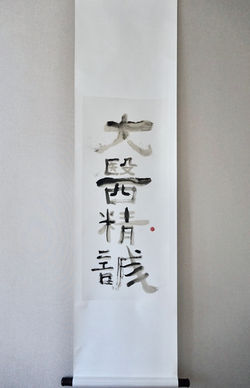 |  |
|---|---|
 |  |
 |  |
 |  |
 |  |
 |  |
 |  |
Painted with materia medica—iodine, an antiseptic, and anti-inflammatory herbs used in traditional Chinese medicine and textile dyeing—this body of work embodies a somatic reintegration of ancestral healing knowledge. My great-grandfather was a pastor and surgeon trained by British missionaries at the first Western hospital in China. My grandmother worked with barefoot doctors during the Cultural Revolution, providing primary care in rural Zhejiang while practicing sutra calligraphy as nightly ritual.
Drawing from the Huangdi Neijing (Inner Canon of the Yellow Emperor), a foundational Chinese medical text, reinterpreted through the embodied knowledge and labor of diasporic women, this work constitutes both research and prayer—for family members living with chronic pain and cancer, as well as for collective restoration. I propose an alternative canon: where scientific, spiritual, ecological, and feminist epistemologies coexist; where healing is not the absence of disease, but presence of connection.
